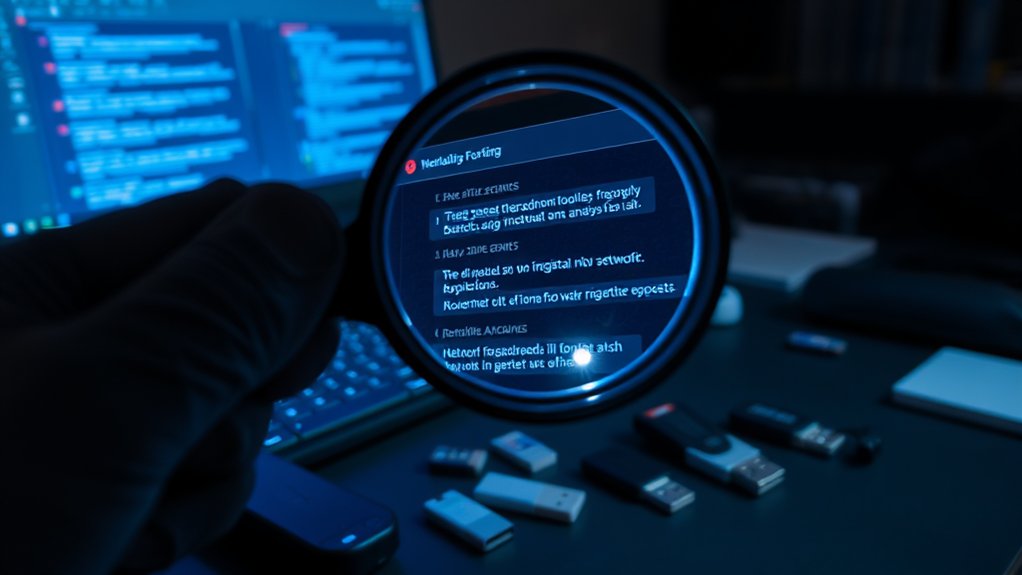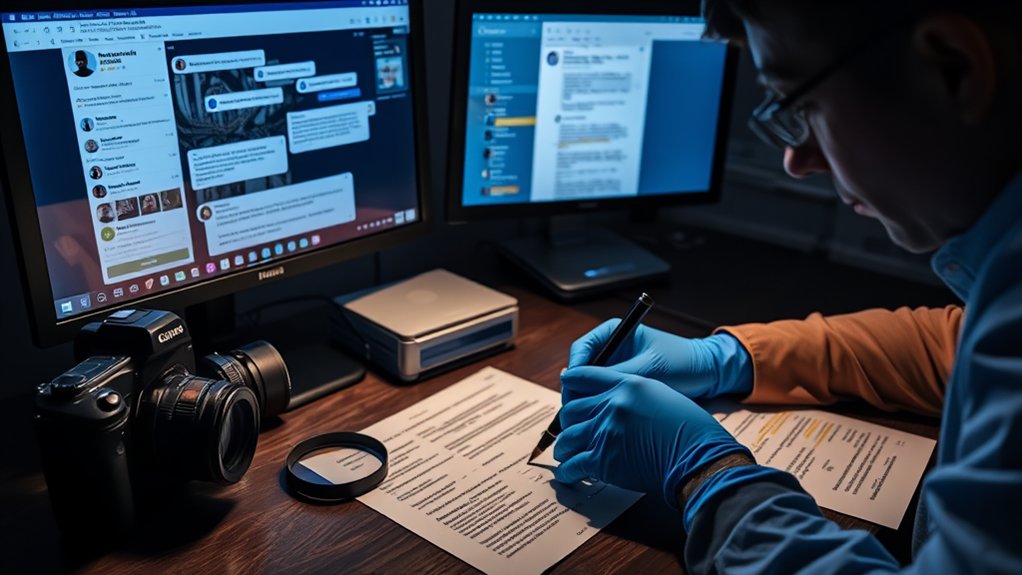Private investigators require digital forensics capabilities to effectively combat modern cyberbullying tactics. Advanced techniques like metadata extraction, hash verification, and forensic imaging enable investigators to collect, authenticate, and preserve digital evidence across multiple platforms. Specialized tools assist in documenting online harassment, recovering deleted content, and maintaining proper chain of custody for legal proceedings. The evolving nature of digital platforms and encryption methods demands continuous adaptation of investigative approaches and methodologies.
Key Takeaways
- Digital forensics tools enable investigators to capture and preserve evidence across multiple platforms while maintaining legal admissibility.
- Modern cyberbullying tactics require specialized knowledge of metadata analysis and encrypted communications to track anonymous perpetrators.
- Proper forensic documentation and chain-of-custody protocols ensure collected evidence meets court requirements for successful prosecution.
- Advanced recovery methods allow investigators to retrieve deleted messages and files crucial to establishing patterns of harassment.
- Digital forensics helps track coordinated group attacks across various platforms while maintaining verifiable evidence timelines.
The Evolution of Cyberbullying Tactics

Various cyberbullying tactics have evolved greatly since the early days of digital communication in the 1990s. What began as simple email harassment and basic message board intimidation has transformed into sophisticated social media tactics that exploit multiple platforms simultaneously. Modern cyberbullies utilize technological tools to amplify their reach, manipulate digital content, and coordinate group attacks.
The anonymity impact has intensified as perpetrators leverage encrypted messaging apps, virtual private networks, and temporary accounts to mask their identities. They employ techniques such as doxxing, deep fakes, and cross-platform harassment campaigns. Cyberbullies now orchestrate sophisticated psychological warfare through calculated timing of attacks, strategic information gathering, and manipulation of digital footprints. These evolved methods create complex challenges for investigators who must track and document evidence across numerous digital channels and platforms. Our certified forensic examiners can analyze evidence from multiple digital devices to uncover vital documentation of cyberbullying activities within approximately 8 hours.
Digital Evidence Collection and Verification
With the increasing sophistication of cyberbullying tactics, digital forensics investigators must employ precise methodologies to collect and authenticate digital evidence. The process requires systematic documentation of the digital footprint while maintaining evidence preservation standards throughout the investigation.
| Evidence Type | Collection Method | Verification Protocol |
|---|---|---|
| Social Media | API Extraction | Hash Verification |
| Text Messages | Device Imaging | Metadata Analysis |
| Email Records | Server Logs | Digital Signatures |
| Images/Videos | Forensic Tools | EXIF Data Check |
| Browser Data | Cache Recovery | Timeline Matching |
Investigators utilize specialized software to capture screenshots, archive communications, and extract metadata while maintaining chain of custody. This methodical approach guarantees the authenticity and admissibility of evidence in legal proceedings, enabling investigators to construct a thorough timeline of cyberbullying incidents and establish patterns of behavior. Technological proficiency has become essential for private investigators to effectively leverage digital tools and forensics in modern investigations.
Tools and Techniques for Online Investigation
Investigators rely on an extensive suite of specialized digital forensics tools to conduct thorough online investigations of cyberbullying incidents. These tools include advanced social media monitoring software, data extraction programs, and digital evidence preservation systems that maintain chain of custody requirements.
Key investigative techniques focus on tracking digital footprints across multiple platforms while ensuring cyber safety protocols. Investigators employ network analysis tools to map communication patterns, metadata extraction software to verify time stamps and source information, and automated screenshot capture utilities to document harmful content. Advanced recovery methods can retrieve deleted messages and restore corrupted files that may contain evidence of harassment. Additionally, specialized analytics platforms help identify patterns of behavior, recurring keywords, and potential connections between multiple cyberbullying incidents across different online environments.
Data carving techniques enable investigators to recover hidden or deleted evidence that perpetrators attempt to conceal from their devices.
Building Court-Ready Documentation

Proper documentation of digital evidence forms the cornerstone of successful cyberbullying prosecution in legal proceedings. Private investigators must maintain detailed records of their investigative process, including timestamps, data collection methods, and chain of custody documentation. Evidence preservation requires systematic logging of all digital artifacts, from social media posts to text messages, using court-approved forensic tools.
To guarantee legal compliance, investigators create thorough reports that detail their methodology, findings, and analysis. These reports must include metadata preservation, hash values for digital files, and authentication procedures that verify the integrity of collected evidence. Additionally, all documentation should follow jurisdiction-specific requirements and industry standards for digital forensics, incorporating detailed photographs, screenshots, and archived copies of electronic communications that demonstrate the pattern of cyberbullying behavior. Similar to pre-employment screening processes, thorough background checks of suspected cyberbullies can provide crucial context for building a stronger legal case.
Challenges in Modern Cyberbullying Cases
Contemporary cyberbullying cases present numerous technical and procedural challenges due to the evolving nature of digital platforms, encryption methods, and anonymizing technologies. Investigators must navigate complex digital landscapes while maintaining victim anonymity and documenting emotional impact on affected individuals.
| Challenge Category | Impact on Investigation |
|---|---|
| Platform Evolution | Rapid changes in social media architecture require continuous adaptation of forensic methods |
| Data Encryption | Advanced encryption protocols complicate evidence retrieval and authentication |
| User Anonymity | Multiple accounts and identity masking tools hinder perpetrator identification |
The integration of multiple messaging platforms, coupled with sophisticated deletion techniques, creates significant obstacles in evidence preservation. Investigators must also consider jurisdictional boundaries when dealing with international platforms while ensuring the psychological well-being of victims throughout the investigation process. Call log analysis and recovered text messages provide crucial evidence for establishing patterns of harassment and strengthening legal claims against perpetrators.
Frequently Asked Questions
How Much Do Digital Forensics Services Typically Cost for Cyberbullying Investigations?
Digital forensic pricing for cyberbullying investigations typically ranges from $2,000-$5,000, with investigation costs varying based on data volume, device types, and analysis complexity. Hourly rates average $150-300 per hour.
What Is the Average Timeframe to Complete a Cyberbullying Investigation?
Investigation duration for cyberbullying cases typically ranges from 2-8 weeks, depending on data volume, platform complexity, and cyberbullying timeline patterns. Complex investigations involving multiple platforms may require extended analysis periods.
Can Digital Forensics Recover Deleted Cyberbullying Content From Social Media?
Digital forensics specialists can recover deleted social media content through specialized evidence recovery tools, cached data analysis, server-side retrieval, and metadata examination, though success rates vary by platform and timing.
Do Private Investigators Need Special Certifications for Digital Forensics Work?
Professional certification requirements include specialized investigator training in digital forensics, computer science, and evidence handling. Industry-standard certifications like EnCE, GCFE, and CFCE validate technical competency for practitioners.
What Percentage of Cyberbullying Cases Are Successfully Resolved Through Digital Forensics?
Statistical data indicates case resolution rates vary between 40-65% when digital forensics is properly employed, though investigation success depends heavily on evidence preservation and technological sophistication of perpetrators.
Conclusion
Digital forensics remains essential for private investigators handling cyberbullying cases, providing scientifically sound methods for evidence collection, verification, and documentation. Through systematic application of digital investigation tools, proper chain of custody protocols, and forensically sound techniques, investigators can effectively document online harassment patterns and preserve court-admissible evidence. This technical approach guarantees investigations meet legal requirements while adapting to evolving cyberbullying methodologies across multiple digital platforms.






